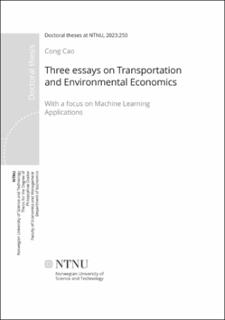| dc.description.abstract | This thesis uses machine learning and traditional statistical approaches to explore air pollution, mortality, and different aspects of transportation to draw forth policy recommendations regarding climate change and sustainable development.
Air pollution caused by traffic, and its resulting health effects, have become increasingly recognized as a source of public concern. Poor urban air quality poses a significant risk to the environment and human health: It increases the incidence of respiratory diseases, especially among those living near major traffic routes and highways.
Effective policies to address these externalities rely on a clear understanding of the links between traffic volume and air pollution. One problem is that the mechanism between air pollution and health outcomes is complicated due to confounders such as meteorological conditions. A second problem is that traditional approaches for predicting air pollutant concentration are prone to overfitting when faced with high-dimensional, small-sample data, and where there are nonlinear relationships. We, therefore, propose several machine learning approaches as an emerging technology that has the potential to address these issues.
In the first two chapters, we study the health consequences of traffic-induced air pollution. We do this by analyzing several sources of Norwegian administrative data and comparing the prediction performance of machine learning and traditional statistical approaches. We also introduces optimal policy recommendations for reducing air pollution from traffic volume, and for mitigating the negative health impacts.
In the third chapter, we explores the relationship between alcohol availability and traffic accidents in Norway. Alcohol availability has been demonstrated to influence a range of social outcomes, including traffic accidents, injuries, and fatalities. Existing literature has focused primarily on on-premises availability, yet there are marked variations in off-premises availability with the potential for large effects on traffic safety. We return to this issue in Norway and exploit large changes in the off-premises availability of high-strength alcohol availability through the expansion of government wine monopoly stores over the last 20 years. We demonstrate variations in the effect of off-premises availability according to the margin of adjustment. Our results have implications for alcohol and road safety policy.
Sammendrag
Denne oppgaven bruker maskinlæring og tradisjonelle statistiske tilnærminger for å utforske luftforurensning, dødelighet og ulike aspekter ved transport for å trekke frem politiske anbefalinger angående klimaendringer og bærekraftig utvikling.
Luftforurensning forårsaket av trafikk, og dens påfølgende helseeffekter, har i økende grad blitt anerkjent som en kilde til offentlig bekymring. Dårlig luftkvalitet i byer utgjør en betydelig risiko for miljøet og menneskers helse: Det øker forekomsten av luftveissykdommer, spesielt blant de som bor nær store trafikkveier og motorveier.
Effektive retningslinjer for å håndtere disse eksternalitetene er avhengig av en klar forståelse av sammenhengen mellom trafikkvolum og luftforurensning. Et problem er at mekanismen mellom luftforurensning og helseutfall er komplisert på grunn av konfoundere som meteorologiske forhold. Et annet problem er at tradisjonelle tilnærminger for å forutsi luftforurensningskonsentrasjon er utsatt for overtilpasning når de står overfor høydimensjonale data med små utvalg, og der det er ikke-lineære sammenhenger. Vi foreslår derfor flere maskinlæringstilnærminger som en fremvoksende teknologi som har potensial til å løse disse problemene.
I de to første kapitlene studerer vi helsekonsekvensene av trafikkindusert luftforurensning. Dette gjør vi ved å analysere flere kilder til norske administrative data og sammenligne prediksjonsytelsen til maskinlæring og tradisjonelle statistiske tilnærminger. Vi introduserer også optimale politiske anbefalinger for å redusere luftforurensning fra trafikkvolum, og for å redusere de negative helseeffektene.
I det tredje kapittelet utforsker vi sammenhengen mellom alkoholtilgjengelighet og trafikkulykker i Norge. Alkoholtilgjengelighet har vist seg å påvirke en rekke sosiale utfall, inkludert trafikkulykker, skader og dødsfall. Eksisterende litteratur har først og fremst fokusert på lokal tilgjengelighet, men det er markante variasjoner i tilgjengelighet utenfor lokaler med potensial for store effekter på trafikksikkerhet. Vi kommer tilbake til denne problemstillingen i Norge og utnytter store endringer i tilgjengeligheten utenfor lokaler av høystyrke alkohol gjennom utvidelse av statlige vinmonopolbutikker de siste 20 årene. Vi viser variasjoner i effekten av tilgjengelighet utenfor lokaler i henhold til justeringsmarginen. Resultatene våre har implikasjoner for alkohol- og trafikksikkerhetspolitikken. | en_US |
